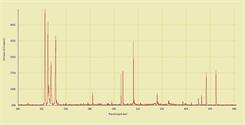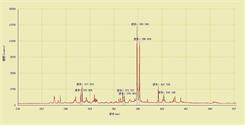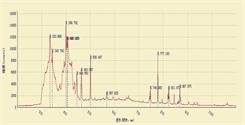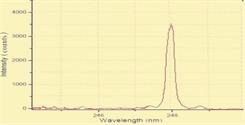|
|
|
|
|
Laser Induced
Breakdown
Spectroscopy
System |
|
|
Laser induced breakdown
spectroscopy (LIBS) is a detection technology that uses pulsed
laser to cauterize substances to produce plasma, and uses plasma
emission spectroscopy to qualitatively or quantitatively analyze
the element composition of substances. In this technology, the
transient plasma is generated by the interaction between
high-power density laser and material, and the atomic and ion
emission spectra in the plasma are collected by optical system.
The qualitative or quantitative analysis of chemical elements is
realized by analyzing the spectral information.
CNI launched
laser induced breakdown spectroscopy system is compact,
integrated, fast and easy to use. The system can directly detect
the samples without without collecting and preparing samples
separately. It made features of rapid analysis and real-time
detection of multi-elements. At the same time, the system can
adapt to the harsh testing environment and can be used for
detection and analysis of solid, liquid, gas samples and slurry
substances. It is widely used in the fields of environmental
monitoring, alloy detection and ore detection, etc. It is a
practical analytical instrument in laboratory and industrial
field. |
 |
-
Coaxial design of
excitation optical path
and acquisition optical
path
-
Internal control/
external control dual
mode
-
Output Q signal
synchronously
-
Two-dimensional
precision adjustment
platform is installed in
the sample room
-
The height of the
lifting platform can be
adjusted to realize the
detection of samples of
different sizes
-
Integrated system design
and simple operation
|
|
|
|
|
■
Laser
Selection |
|
|
|
Solid
Substance LIBS Detection |
Metal
sample
(e.g., metal, alloy, steel, mineral,
etc.) |
High
energy pulse laser
E:100μJ~10mJ |
The sample
has good thermal conductivity, and the
laser energy is high enough. |
|
Non
metallic multi component sample
(e.g.,heavy metals in soils, NPK
fertilizer detection, coal quality
analysis etc.) |
Low
frequency high energy pulse laser
E:10mJ~100mJ |
The thermal
conductivity of the sample is not good,
the high temperature will lead to
chemical reaction or burning. |
|
Liquid
Substance LIBS Detection |
Liquid
sample
(e.g., sea water, industrial waste water
detection, etc.) |
High
energy pulse laser
E:100mJ~500mJ |
Due to the
plasma shock wave action, the liquid
level fluctuation will affect the
detection stability. |
|
Gaseous
Substance LIBS Detection |
Gases and
aerosols
(e.g., air, air pollutants, automobile
exhaust, industrial waste gas, etc.) |
Low
frequency high energy pulse laser
E:500mJ~1000mJ |
Gas
breakdown threshold is high, need high
energy laser as the excitation light
source. |
|
|
|
|
■
Sample
LIBS Spectrum |
 |
 |
 |
|
Copper-aluminum alloy LIBS spectrum |
Cr: YAG LIBS spectrum |
Granite LIBS spectrum |
 |
 |
 |
|
Plant leaves LIBS spectrum |
Air LIBS spctrum |
Soil
LIBS spectrum |
|
|
|
|